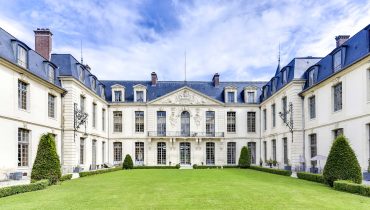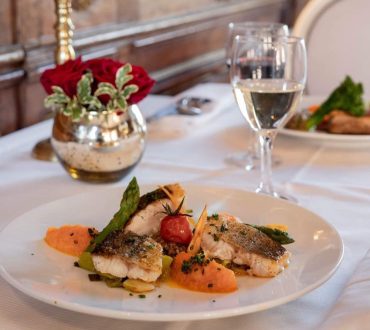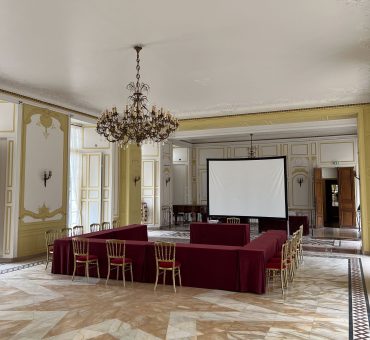The history of Château d’Ermenonville
An establishment steeped in history
Of course, some details have been lost in the passage of time, but the chronicle of the Château d’Ermenonville nevertheless reflects its exceptional destiny, that of great fortunes. Illustrious figures make up the list of guests, hosts and visitors who have passed through this majestic setting: Kings Louis XI and Henri IV, Swiss philosopher and author Jean-Jacques Rousseau, who spent the last six weeks of his life here, Polish Prince Constantin Radziwill and automobile designer and manufacturer, Ettore Bugatti, to name but a few.
Château d’Ermenonville embodies eleven centuries of history, making it a priceless jewel in France’s historic and architectural heritage.
In 987, Hugues Capet was made King of the Franks in the nearby château of Senlis, putting an end to the Carolingian dynasty. Nearby Ermenonville was chosen as a strategic location to assert this new rule. The citadel, formerly known as ‘Irminon Villa’, became the site of a fortress controlled by the Counts of Senlis and the first Kings of France.
Its purpose was to regulate traffic between the new home of the Capetians and the major markets of the East. The edifice was typical of medieval defensive architecture: a fortified castle with an enclosure surrounded by crenellated towers, a moat and drawbridge.
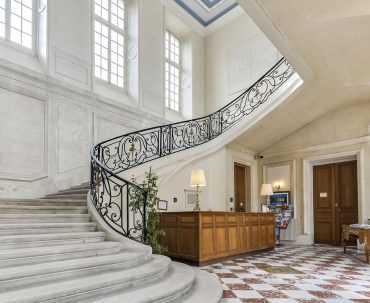
The château was burnt down during the Great Jacquerie revolt of 1358, a peasant uprising in the Île-de-France, Picardy, Champagne, Artois and Normandy countryside. It took Robert de Lorris, Lord of Ermenonville, herculean efforts to restore it to its former glory.
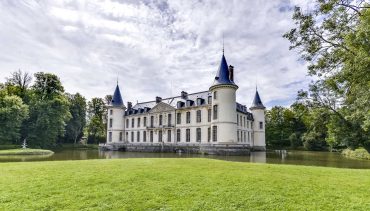
In the 15th century, King Louis XI stayed here three times, seeing in the château sufficient prestige to host his royal entourage while passing through the Valois region.
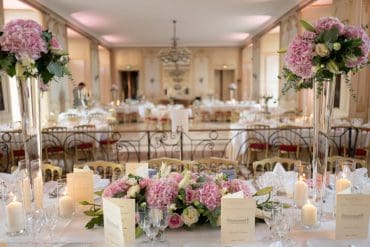
Owned by Vice Admiral Dominique de Vic in 1592, a comrade-in-arms of Henri IV who had been left with a wooden leg as a result of combat, the château was still favoured by royalty, and was the chosen setting of assignations between good King Henri and his favourite mistress, Gabrielle d’Estrées.
It was at this time that the lordship of Ermenonville became a viscounty. In this period, its architecture continued to bear the hallmarks of medievalism, with its austere façades, turrets and imposing keep.
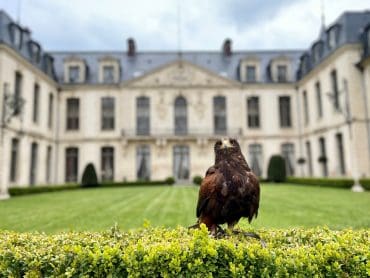
Its current guise, inspired by the architectural canons of the Age of Enlightenment, is the work of Seigneur Claude-Louis Lombard, the new master of the estate in 1728.
The château was redesigned as a residence of pleasure, with side wings, many large windows and a central section decorated with heraldic pediments and wrought-iron balconies. As for the keep, by then a relic of the Middle Ages, it was simply demolished.
The renovations were colossal, but afforded the Château d’Ermenonville the prestige it has enjoyed ever since.
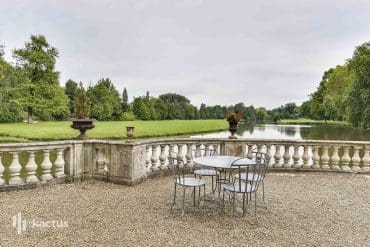
First passed down through the Lombard family, the building was sold in 1754 to René Hatte, King Louis XV’s tax collector, who then passed it on to his grandson, the Marquis René-Louis de Girardin, in 1763.
The Marquis de Girardin commissioned a complete modernisation of the château’s interior fittings and the opening up of the views over the south park. However, he devoted most of his time and energy to transforming the estate’s Grand Parc into an English-style garden.
Jean-Jacques Rousseau’s epistolary novel, ‘Julie or the New Heloise’, inspired him to create an ‘informal’ garden with a distinctly pastoral feel. Elegant disorder and picturesque landscapes accentuate its romantic feel, so conducive to philosophical wanderings.
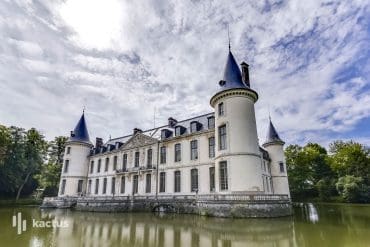
Swiss philosopher and writer, Jean-Jacques Rousseau, who died on 2 July 1778, spent the last six weeks of his life at the Château d’Ermenonville and was buried on the Île des Peupliers in the Grand Parc, attracting many illustrious figures to the château, including Marie-Antoinette, Benjamin Franklin, Robespierre, Mirabeau, Danton, Saint-Just, Camille Desmoulins and Sweden’s King Gustav III.
Renowned landscape painter, Hubert Robert, designed his tomb, decorated with bas-relief that depict allegories of freedom, nature and truth.
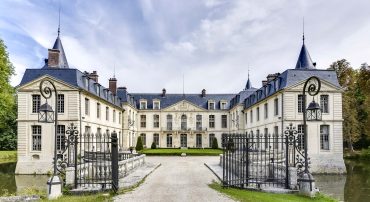
Divided into lots upon succession of the Marquis de Girardin and his descendants, the château was subsequently acquired by Marie-Charlotte Hensel in 1876 as a dowry for her daughter Louise, the wife of Polish Prince Constantin Radziwill.
Major restoration work was undertaken by the family, who lived at the château until 1927, when the last descendant, Léon Radziwill, son of Prince Constantin, died.
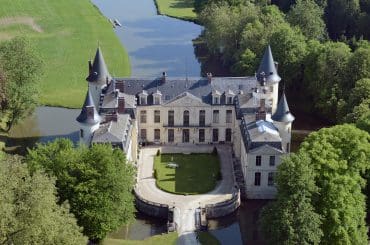
Three years later, the Île des Peupliers, the Temple of Modern Philosophy and several other follies in the Grand Parc, as well as the château itself, were listed in France’s Supplementary Inventory of Historic Monuments (decree of 11 June 1930).

In 1932, Ettore Bugatti, one of the celebrated founders of the automobile industry, bought the château and its park, and proceeded to dismantle it. The furniture, inventory and all the collections, including souvenirs of Jean-Jacques Rousseau’s stay and objects belonging to the Marquis René-Louis de Girardin, were sold separately from the estate, forever scattering them among art dealers and collectors.
At this time Ettore Bugatti also sold off land to the west and east of the Petit Parc adjacent to the château. The Grand Parc was purchased by the Touring Club de France in 1938 to preserve it. Subsequently opened to the public, it was officially renamed the Jean-Jacques Rousseau Park.
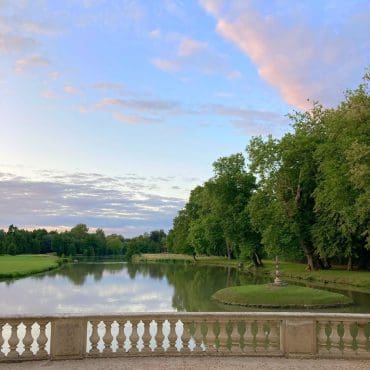
From 1964, the château became a hotel and restaurant operating as a ‘Relais & Châteaux’ establishment under the impetus of its new owner, Dr Henri Montarnal, who later transformed it into a retirement home.

Bought out in 1991 by the Philippe Savry group, owner of Les Hôtels Particuliers, it was transformed into a high-end hotel.
A film location, it was also used as a set for Jean-Marie Poiré’s comedy films, ‘Les Visiteurs’ and sequel ‘Les Couloirs du Temps’, engraving a number of cult scenes into the French collective memory and offering an excuse for film buffs to visit the château.
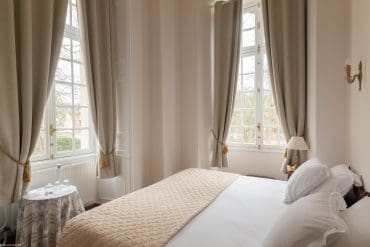
Once owned by the Luxempire group, which created a dinosaur park here, the Château Ermenonville estate joined the Terres de Natures label in 2022, driven by the vision of entrepreneur Matthieu Gufflet to make it a historic stopover in the heart of stunning natural surroundings.
Today, the château, perched above the water, with its moat and 18 hectares of parkland divided in two by the Launette river, offers guests all the wonder of a setting whose soul is as vibrant as its authenticity is unspoilt.
